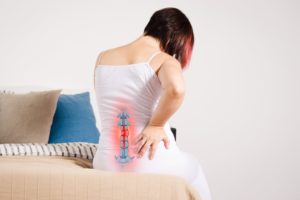
Millions of people visit the doctor each year for back pain. One cause of back pain could be what is known as a slipped disc. The spine is made up of bones known as vertebrae that stack one on top of the other. In between each of these vertebrae are spinal discs that help provide cushion and support. Issues with your spinal discs, like a slipped disc, can cause pain and discomfort. Visit your Lithia Springs chiropractors if you think you are dealing with a slipped disc and find out how you can experience lasting relief.
What Is a Slipped Disc?
When a spinal disc is functioning properly, it sits between two vertebrae and helps with shock absorption. Spinal discs also keep the bones in your spine from rubbing against one another. A spinal disc has a tough outer shell that protects a soft, gel-like center. When a spinal disc is damaged, it can cause a crack or tear in the outer shell and the inner portion to protrude. A slipped disc refers to the inner portion of the spinal disc aggravating or compressing nearby nerves in your spinal column.
Signs and Symptoms of a Slipped Disc
There are several signs and symptoms of a slipped disc. Here is what a slipped disc feels like.
Pain When Sitting or Standing
You may notice pain in your back and elsewhere when you are sitting or standing. This pain can get worse when you move from a seated position to standing, or vice versa. Your posture while sitting or standing can put additional pressure and stress on the area where the slipped disc is located.
Pain While Trying to Sleep
A slipped disc can cause you pain and discomfort when you are trying to go to sleep. You may have trouble finding a comfortable position to sleep in because of the pain. The pain may occur in and around the area where the slipped disc is located. A slipped disc can also cause pain and discomfort in other parts of the body controlled by the compressed nerve.
Tingling in Arms or Legs
A slipped disc can also cause a tingling sensation in your extremities, like your arms or legs. This tingling sensation may also feel like ‘pins and needles’ like when you have been sitting with your legs crossed for too long and your foot “falls asleep.” Tingling in your arms or legs can occur when the nerves that send signals to these areas are aggravated or compressed by the slipped disc.
Weakness or Numbness
Weakness and numbness are also possible signs and symptoms of a slipped disc. In addition to pain and tingling, you may also experience muscle weakness in your arms or legs. A slipped disc can also cause short periods of numbness in the areas where you also experience the tingling or pins and needles sensations.
Slipped Disc vs. Herniated Disc
You might be wondering, what’s the difference between a slipped disc and a herniated disc? These are actually two terms that describe the same condition! A herniation refers to something that is protruding abnormally. When the inner nucleus of a spinal disc protrudes through a crack or tear in the outer shell, it is called a herniated or slipped disc. Another type of spinal disc issue is known as a bulging disc. Bulging discs are different than slipped or herniated discs because with a bulging disc, the outer shell of the spinal disc stays intact.
Causes of a Slipped Disc
A slipped disc can occur for a number of reasons. One of the most common causes of a slipped disc is general wear and tear on the body due to aging. As we age, spinal discs start to lose their elasticity and can start to dry out. When this happens, the spinal disc is more prone to cracking or tearing. Certain movements can also lead to a slipped disc, like heavy lifting. When you put a lot of pressure on your back when you strain to lift a heavy object, it can result in a slipped disc. Demanding jobs that require repeated heavy lifting can put you at greater risk of developing a slipped or herniated disc. A sudden injury to the spine can also cause a slipped disc, like a car accident injury.
Diagnosing a Slipped Disc
If you suspect you have a slipped disc, then you will want to see your Lithia Springs chiropractor to confirm. A chiropractor can diagnose a slipped disc by performing a physical exam of your spine and areas where you experience symptoms. A chiropractor can use diagnostic techniques to test your nerve functioning and check for negatively affected muscle strength. They may also ask you to perform certain movements. Talk to your chiropractor about when you first started noticing your symptoms and if a sudden injury or issue prompted them. In some cases, your chiropractor may want to run diagnostic imaging tests like an X-ray or CT scan to get a clearer picture of the affected area.
Relieving Your Slipped Disc Symptoms
If left untreated, you risk dealing with permanent nerve damage. Your Lithia Springs chiropractor can help you experience lasting relief from your slipped disc symptoms by addressing the root cause. Chiropractors use an all-natural and conservative approach to treating your slipped disc. Stretches and exercises can help strengthen the muscles that support your spine, which can help provide stability and reduce your pain. Chiropractic adjustments can help restore healthy alignment to your spine and resolve any misalignments in your spine. Visit AICA Orthopedics Lithia Springs chiropractors if you are feeling any of the signs or symptoms of a slipped disc mentioned above. Our team of chiropractors can provide you with quality, comprehensive care, and a personalized treatment plan. At AICA Orthopedics in Lithia Springs, we also offer diagnostic imaging in the office, so you can experience the convenience of visiting your chiropractor and getting all the tests you may need all in one convenient location!
